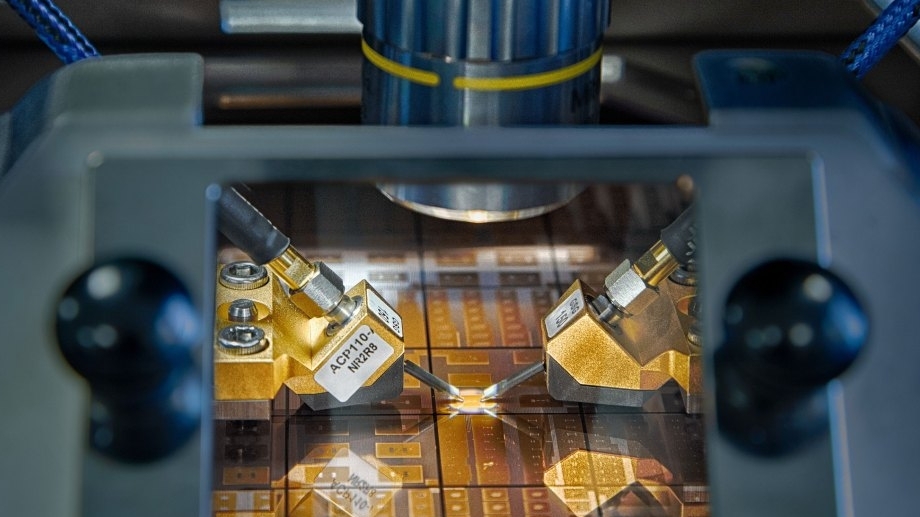5G or radar are RF applications that depend on the right materials and connections. A new working group at the IZM is tackling this issue. In RF applications like 5G or radar the right materials and connections are essential. A new working group at IZM is addressing this issue.
The performance of high-frequency applications such as 5G or radar depends primarily on the materials and connections used. A new working group has been established at Fraunhofer IZM in Berlin to investigate and optimize these. The researchers' expertise is used to design high-frequency structures in such a way that optimal wave transmission is made possible.
According to a study by technology analyst Yole Développement [1], the market for high-frequency modules in the telecommunications sector alone will more than double in the next five years. The telecoms market and developments in the automotive and radar sectors are just a few examples of how high-frequency technology is not only already an integral part of today's world, but must also be seen as paving the way for tomorrow's innovative electronic solutions.
The Fraunhofer Institute for Reliability and Microintegration IZM has been developing technologies for high-frequency applications for over 20 years. A new group has now been established under the leadership of Oliver Schwanitz to investigate the prerequisites for all these developments: High-frequency materials and their connection technologies. This is a huge spectrum, as the decision for a substrate material is also decisive for how much power can be transported - in other words, which applications are made possible.
The group has been involved in important research projects since its inception. For example, it is currently developing millimeter wave modules in conjunction with other working groups for future radar applications in vehicles and is already researching the next but one mobile communications standard in the 6GKom project, while 5G is currently being implemented. Companies from other sectors, such as the chemical and pharmaceutical industries, are also requesting the services of Schwanitz's group to characterize the electrical values of their materials.
As part of its specialization, the 'RF Materials & Interconnects' group can investigate which materials are suitable for use in RF applications without any loss or change in performance. In the run-up to measurements, for example, simulations are created that reproduce the ideal signal curve in reality. In the process, the researchers test materials and connections so that the applications can be realized as close to the simulation as possible and with as little loss as possible.
The fundamental aim is to gain a holistic understanding of the influences of the high-frequency properties of materials. The key point here is that the permittivity and dielectric loss factor of a material play a significant role in the expected performance of RF structures. In order to operate in a higher frequency range, as is necessary for 5G and radar, for example, precisely these values must be determined in advance - only then can the system be expected to function at the designed frequency and deliver the corresponding performance.
"I would also like to move in the direction of material development."
Measuring with conventional multimeters is impossible in high-frequency technology because the amplitudes involved are so small and location-dependent, e.g. in the millimeter-wave range, that other measurement techniques are required for validation or verification. The researchers in the group have a semi-automatic helper for investigating high-frequency materials and their connections: a network analyzer with wafer prober, which is part of the Research Fab Microelectronics Germany at Fraunhofer IZM. This enables the researchers to examine RF structures in a wide range of temperatures (-20 °C to 150 °C) up to a frequency of 500 GHz.
Due to its applicability to all RF developments, the group's expertise is already in demand in many projects - but they also have their own plans for the future. Group leader Schwanitz explains: "I would also like to move in the direction of materials development. We are particularly interested in so-called metamaterials, i.e. materials whose electrical properties do not occur naturally. These can be used to create very special properties, such as significantly lower loss properties with increasing temperature However, these are still absolutely future-oriented areas, and in order to achieve them or make them ready for industrial use, a transformation from theoretical research vehicle to concrete and functioning prototypes must take place."
For now, however, the group is focusing on existing projects and is making a significant contribution to the realization of innovative high-frequency applications through material characterization and the design of interconnects. One of the main projects is the 6GKom project of the ForMikro funding guideline of the Federal Ministry of Education and Research. In this project, a module is being developed with other project partners that is intended for the upcoming 6th generation of mobile communications. "This may sound strange," says Schwanitz, "as the expansion of 5G mobile communications in Germany has only just begun, but it is essential for Germany as a research location not to lose touch internationally."
References:
[1] Yole Développement, GaN RF Market: Applications, Players, Technology and Substrates, Market Technology Report, 2020, p. 30


